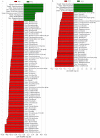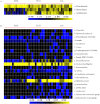An in vitro evaluation of the effects of different statins on the structure and function of human gut bacterial community
- PMID: 32214324
- PMCID: PMC7098552
- DOI: 10.1371/journal.pone.0230200
An in vitro evaluation of the effects of different statins on the structure and function of human gut bacterial community
Abstract
Statins, a class of drugs that can effectively remove cholesterol from serum, are used to regulate plasma total cholesterol and reduce the risk of cardiovascular diseases, but it is still unclear whether the drug are modulated by gut microbiota or the structures of gut microbiota are shaped by statins. We investigated the interactions between statins and the human gut microbiota during the in vitro fermentation process by 16S rRNA gene sequencing, gas chromatography (GC), and high-performance liquid chromatography (HPLC) analyses. The presence of fluvastatin (FLU2) specifically promoted the growth of Escherichia/Shigella, Ruminococcaceae UCG 014, and Sutterella. However, the composition of the gut bacterial microbiota remained relatively static in samples treated with rosuvastatin (ROS), simvastatin (SIM), and atorvastatin (ATO). The PICRUSt program predicted moderate differences in the functional categories related to the biosynthesis of other secondary metabolites, cellular processes and signaling, and signal transduction in the FLU2 fermentation samples. Our study revealed substantial variation in the structure and function of microbiomes from the FLU2-treated samples. In addition, short-chain fatty acids (SCFAs) were also significantly decreased in FLU2-treated samples compared with the samples treated with other stains. Statins can be degraded by the human gut microbiota in vitro, and the degradation rate was approximately 7%-30% and 19%-48% after fermentation was allowed to proceed for 24 h and 48 h, respectively. Generally, FLU2 could largely shape the composition and function of human gut microbiota, which resulted in changes in the production of SCFAs. In turn, all statins could be degraded or modified by the gut microbiota. Our study paves the way for elucidating statin-gut microbiota interactions in vitro towards the improvement of the host health and personalized medicine.
Conflict of interest statement
The authors have declared that no competing interests exist.
Figures







Similar articles
-
Effects of a homogeneous polysaccharide from Sijunzi decoction on human intestinal microbes and short chain fatty acids in vitro.J Ethnopharmacol. 2018 Oct 5;224:465-473. doi: 10.1016/j.jep.2018.06.006. Epub 2018 Jun 15. J Ethnopharmacol. 2018. PMID: 29890316
-
Scutellariae radix and coptidis rhizoma ameliorate glycolipid metabolism of type 2 diabetic rats by modulating gut microbiota and its metabolites.Appl Microbiol Biotechnol. 2020 Jan;104(1):303-317. doi: 10.1007/s00253-019-10174-w. Epub 2019 Nov 22. Appl Microbiol Biotechnol. 2020. PMID: 31758238
-
Fecal metabonomics combined with 16S rRNA gene sequencing to analyze the changes of gut microbiota in rats with kidney-yang deficiency syndrome and the intervention effect of You-gui pill.J Ethnopharmacol. 2019 Nov 15;244:112139. doi: 10.1016/j.jep.2019.112139. Epub 2019 Aug 8. J Ethnopharmacol. 2019. PMID: 31401318
-
A gut feeling of statin.Gut Microbes. 2024 Jan-Dec;16(1):2415487. doi: 10.1080/19490976.2024.2415487. Epub 2024 Oct 29. Gut Microbes. 2024. PMID: 39470680 Free PMC article. Review.
-
The Potential of Pectins to Modulate the Human Gut Microbiota Evaluated by In Vitro Fermentation: A Systematic Review.Nutrients. 2022 Sep 2;14(17):3629. doi: 10.3390/nu14173629. Nutrients. 2022. PMID: 36079886 Free PMC article. Review.
Cited by
-
Role of Gut Microbiome in Atherosclerosis: Molecular and Therapeutic Aspects.Curr Cardiol Rev. 2023;19(4):e020223213408. doi: 10.2174/1573403X19666230202164524. Curr Cardiol Rev. 2023. PMID: 36733248 Free PMC article. Review.
-
Heterogeneity in statin responses explained by variation in the human gut microbiome.Med. 2022 Jun 10;3(6):388-405.e6. doi: 10.1016/j.medj.2022.04.007. Epub 2022 May 11. Med. 2022. PMID: 35690059 Free PMC article.
-
Potential Contribution of Short Chain Fatty Acids to Hepatic Apolipoprotein A-I Production.Int J Mol Sci. 2021 Jun 1;22(11):5986. doi: 10.3390/ijms22115986. Int J Mol Sci. 2021. PMID: 34206021 Free PMC article. Review.
-
The Brain-gut Axis-where are we now and how can we Modulate these Connections?Curr Neuropharmacol. 2021;19(8):1164-1177. doi: 10.2174/1570159X18666201119155535. Curr Neuropharmacol. 2021. PMID: 33213347 Free PMC article.
-
Clinical Relevance of Gut Microbiota Alterations under the Influence of Selected Drugs-Updated Review.Biomedicines. 2023 Mar 20;11(3):952. doi: 10.3390/biomedicines11030952. Biomedicines. 2023. PMID: 36979931 Free PMC article. Review.
References
-
- Hooper LV, Midtvedt T, Gordon JI. How host-microbial interactions shape the nutrient environment of the mammalian intestine. Annual Review of Nutrition. 2002; 22(1): 283–307. - PubMed
Publication types
MeSH terms
Substances
Grants and funding
LinkOut - more resources
Full Text Sources
Miscellaneous

